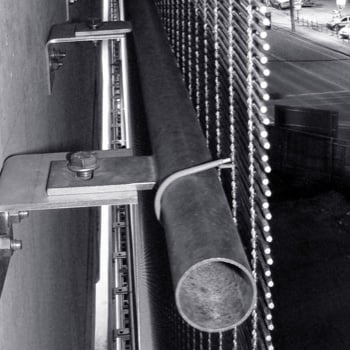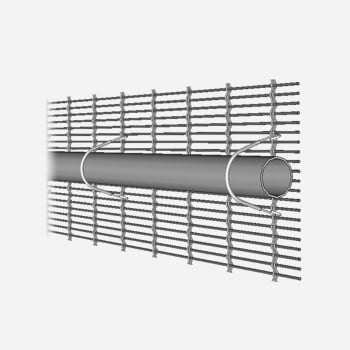Decorative Wire Mesh Systems: Intermediate Tubes
Architectural Mesh - Exterior | Architectural Mesh - Interior
Decorative wire mesh is a rigid design material that delivers a dynamic and modern aesthetic. From bringing an old structure back to life to incorporating safety measures into parking garages, decorative wire mesh panels have an almost endless list of possibilities.
To ensure your mesh performs as intended, a specialized contractor must properly install the system. It is critical that you understand how each element of the decorative wire mesh system works, so you can determine if it matches your vision and identify a suitable contractor.
Intermediate tubes, for example, are an essential part to keeping your mesh safe and robust.
Having guided architects such as yourself through the world of decorative wire mesh for over 20 years, W.S. Tyler looks to leverage the experience we have within our four walls to help you find relief in your design process.
To help you make heads or tails of intermediate tubes and the impact they have on a decorative wire mesh system, the following article will cover:
- What an intermediate tube is
- The purpose of intermediate tubes
- How intermediate tubes are attached to a structure
- The consequences of not using intermediate tubes
What Is an Intermediate Tube?
Intermediate tubes are elements of a decorative wire mesh system that provides additional support along the length of a panel. They do so by keeping the panels in place, preventing drifting and, consequently, damage.

Intermediate tubes often come in rounded poles or flat bars and are placed in specific intervals. So if you have a 50-foot panel, you would see an intermediate tube at the 10-foot mark, 20-foot mark, 30-foot mark, and 40-foot mark.
What Purpose Does an Intermediate Tube Serve?
Intermediate tubes are put in place to help support and manage the tensioning loads put on the substructure of the structure. Having said that, it is essential to know that the intermediate tubes do not carry any of this load themselves.
Instead, they are designed to pull the decorative mesh panels back towards the building. This is so your panels aren't bowing as the wind hits the surface. This means there will be some sort of lateral load put on the intermediate tubes.
But the vertical load of the mesh tensioning will not be put on the intermediate tubes.
How Are Intermediate Tubes Attached to a Structure?
Because there is no weight bearing on the intermediate tubes, they do not require the same substructural support at the top and bottom of the panel.
Instead, there are separation plates welded to the back of the intermediate tube in 24-inch intervals. These separation tabs correlate with mounting tabs on the substructure, allowing the contractor to bolt the intermediate tube to the substructure.
A wire connector is then wrapped around the back of the intermediate tube and attached to the decorative wire mesh panel. These wire connectors occur every 12 inches.
The wire connectors keep the mesh attached to the intermediate tubes and pivot with the mesh, allowing just enough give for the mesh to expand and contrast with the elements.
What Happens if Intermediate Tubes Are Not Used?
As intermediate tubes are used to keep the mesh in place, failure to properly implement them will result in the mesh panels bowing and buckling. After an extended time of the wind causing the mesh panel to continuously flex to and fro, the wires and substructure would become weak.
This would result in damage to the individual wires of the panel, damage to the mounting hardware, or the mesh panel and substructure detaching from the building.
Make the Most Out of Your Mesh With the Right Structural Calculations
Decorative wire mesh systems rely on intermediate tubes to pull each panel back towards the building, preventing it from swaying in the wind. Without them, your mesh panels would bow as the wind hit the surface.
Now, each decorative wire mesh system is like a snowflake in the fact that no one is exactly the same. To ensure the attachment and mounting hardware are sound and put in the right places, the mesh supplier will work with your structural engineers to communicate the structural calculations that you should follow.
W.S. Tyler has worked with architects to weave their vision into reality with decorative wire mesh for 20 years and strives to guide you until you reach results that you are proud of.
To learn about the structural calculations that dictate how your decorative wire mesh panels are installed, review the following article:
About Ronnie Brown
Ronnie is the Content Writer for W.S. Tyler and has four years of experience as a professional writer. He strives to expand his knowledge on all things particle analysis and woven wire mesh to leverage his exceptional writing and graphic design skills, creating a one-of-a-kind experience for customers.




